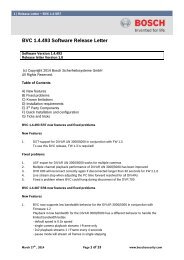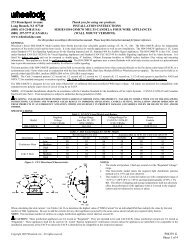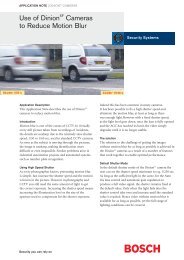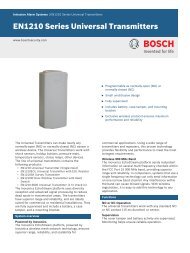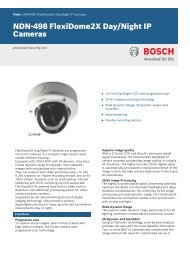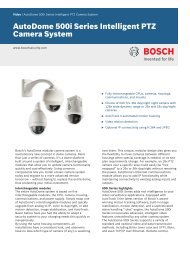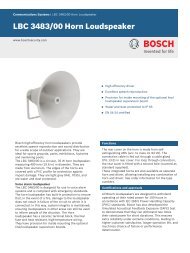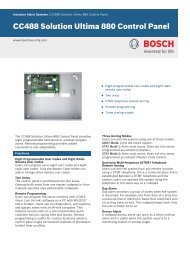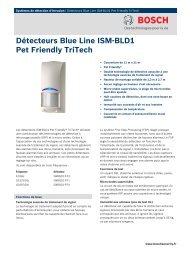VRM Video Recording Manager - Bosch Security Systems
VRM Video Recording Manager - Bosch Security Systems
VRM Video Recording Manager - Bosch Security Systems
Create successful ePaper yourself
Turn your PDF publications into a flip-book with our unique Google optimized e-Paper software.
20 en | Configuring Automatic Network Replenishment <strong>VRM</strong> <strong>Video</strong> <strong>Recording</strong> <strong>Manager</strong><br />
10 Configuring Automatic Network Replenishment<br />
Main window > Devices tab > Expand Devices > > <strong>Recording</strong> > <strong>Recording</strong><br />
Management<br />
<strong>VRM</strong> supports Automatic Network Replenishment (ANR) for devices with firmware version 4.0<br />
or above. ANR technology gives the <strong>VRM</strong> system optimum protection against data loss in the<br />
event of network failure. The network failure is registered immediately if the failure is longer<br />
than 10 seconds. Once the network connection has been restored, gaps in the recording are<br />
automatically filled. The ANR technology accurately inserts the missing parts into the gaps in<br />
the <strong>VRM</strong> system recording using the local recording of the device in question.<br />
Cameras in ANR mode save the recording locally on transient LUNs. After a network failure<br />
between a camera and the <strong>VRM</strong> system, the data stored locally during the failure is<br />
automatically transferred to the <strong>VRM</strong> system.<br />
Whenever <strong>VRM</strong> server can establish a network connection to an ANR device, the data saved<br />
there is transferred to the iSCSI system managed by <strong>VRM</strong>.<br />
For devices with firmware 4.10 or greater, you can use ANR on iSCSI targets that are<br />
connected directly to a BVIP device.<br />
Note: A failover <strong>VRM</strong> server cannot perform ANR jobs.<br />
Note: A <strong>VRM</strong> server can perform maximum 3 ANR jobs simultaneously.<br />
Note: If you configure multiple ANR jobs for 1 device (for example with 4 channels), these<br />
jobs are performed one after the other. This avoids overload of the device.<br />
Note: Ensure that disk space available on the transient LUN is sufficient for the recordings<br />
made during the time the network connection is missing.<br />
The device working in ANR mode must already be added to the system.<br />
Follow the steps below to configure a device that works in ANR mode:<br />
1. Under Management mode, select the <strong>Recording</strong> 1 managed by <strong>VRM</strong> - <strong>Recording</strong> 2 used<br />
for ANR option.<br />
2. In the Local Media tab, select the storage medium on which local recording should take<br />
place. Depending on the device, different media will be available.<br />
3. Click Add to add the selected medium to the disk space in use.<br />
4. Ensure that the Rec. 2 option is activated for a storage medium in the list; otherwise,<br />
ANR is not possible.<br />
Click to ckeck Overwrite older recordings – <strong>Recording</strong> 2.<br />
Note: To remove a medium from the list of available storage media, select the device and<br />
click Remove.<br />
5. Select the associated target in the Storage <strong>Systems</strong> main node and ensure that<br />
Transient type is set for the corresponding LUN.<br />
DOC | V.2.21 | 2011.12 Operator's Manual <strong>Bosch</strong> Sicherheitssysteme GmbH



